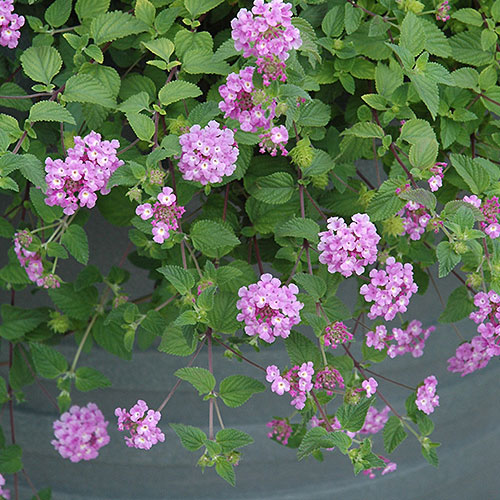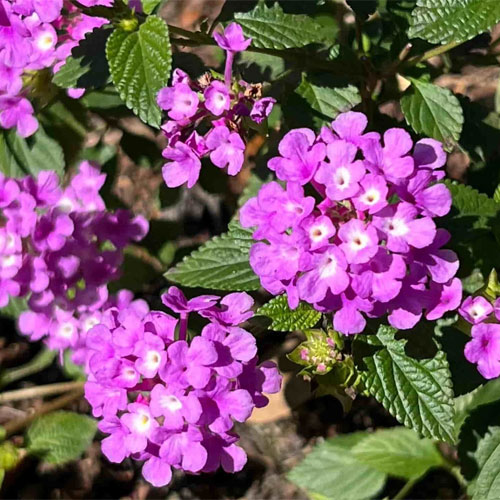Transform your garden space with the stunning Lantana Purple Dwarf Bush Live Plant, a compact beauty that offers clusters of bright purple flowers and a neat, bushy shape. Perfect for home gardens, borders, or balcony pots, this ornamental plant is a low-maintenance showstopper. Loved for its long flowering season and butterfly-attracting blooms, it adds vibrant color and charm to any space.
Variety Name: Lantana Purple Dwarf
Type of Plant: Flowering Ornamental Live Plant (Bush Type)
Germination Time: Not applicable (live plant)
Sunlight Requirements: Full sunlight (6–8 hours/day)
Growing Locations: Outdoors, balcony pots, borders, home gardens
Growing Season: Best planted from February to October
Seed Sowing Depth: Not applicable
Ideal Climate: Tropical, subtropical, and moderate climates
Plant Height: Grows up to 1.5 to 2 feet
Fertilizer Needs: Monthly application of compost or organic fertilizer
Life Span: Perennial
Ideal Growing Temperature: 20°C to 35°C
Blooming Time: Throughout the year (peak in spring & monsoon)
Maintenance Required: Low
Watering Frequency: Twice a week or when soil dries
Ideal Grow Bag Size: 12x12 inch or 15x15 inch grow bags


In India, Lantana Purple Dwarf performs best during the spring, summer, and monsoon months. It is ideal to plant from February to October. In South Indian states like Kerala, Tamil Nadu, and Karnataka, it can bloom almost year-round with proper care.
Choose a medium to large grow bag (12–15 inches) or earthen pot. Fill it with well-drained garden soil mixed with organic compost. Plant in a spot that gets full sunlight. Water when the topsoil feels dry. Regularly pinch off spent flowers to encourage new blooms.
Not applicable as this is a live plant.
For propagation, you may use stem cuttings or layering methods under proper guidance.
Sunlight: Requires 6–8 hours of direct sunlight daily
Soil: Sandy loam or fertile garden soil with good drainage
Fertilization: Add compost once a month
Pruning: Trim back after flowering to keep the shape and boost flowering
Support and Spacing: No support required; spacing of 1.5 feet recommended
Pest Control: Use neem oil spray for whiteflies or aphids
Disease Prevention: Avoid overwatering to prevent root rot
Mulching: Helps retain moisture and keeps weeds away
Harvesting: Ornamental only – not edible
1. Apply Nutrient-Rich Fertilizers
When your plants begin flowering, use nutrient-rich fertilizers like Organic Bone Meal Powder or Vermicompost. This helps in boosting the bloom and enhances overall yield.
2. Use Organic Fertilizers
Feed your plants with organic fertilizers such as Cow Dung Manure or Neem Cake. Organic options promote healthy soil life.
3. Regular Feeding
Apply fertilizers every 20-25 days to ensure plants receive a steady supply of nutrients. Choose from various options like Cocopeat Compost for
The Lantana Purple Dwarf Plant is a hardy, disease-resistant bush that thrives in heat and minimal water. Its mounding shape makes it ideal for borders, landscape design, or small garden corners. The clusters of bold purple blooms not only beautify your garden but also attract butterflies and bees, making your space more lively.
Low Maintenance: Very easy to care for, ideal for beginners
Compact Size: Perfect for small gardens, pots, or borders
Butterfly Attractor: Lures pollinators with its vivid blooms
Long Blooming: Flowers profusely in multiple seasons
Decorative Appeal: Enhances garden aesthetics with rich purple flowers
Avoid full shade — blooming may reduce.
Don’t overwater — prefers well-drained soil.
Prune to control spread and maintain compact size.
Keep away from pets and children — some parts may be mildly toxic if ingested.
Leaves Turning Yellow: Check for overwatering or poor drainage.
Lack of Blooms: Ensure 6–8 hours of sunlight and monthly feeding.
Pests: Control aphids or mites with neem oil.
Leggy Growth: Trim back to encourage bushy growth.
Lantana Flower Plant, Lantana Bush, Nandivardhanam (in some regions), Butterfly Bush, Dwarf Lantana Purple, Purple Lantana Pushpa, Lantana Puvvu
Q1: Can I grow this plant indoors?
No, it requires full sunlight and is best grown outdoors.
Q2: Will it bloom year-round?
Yes, it blooms across multiple seasons, with peak in spring and monsoon.
Q3: Is this plant pet safe?
Some parts of the plant may be toxic if ingested, so keep away from pets.
Q4: How often should I fertilize it?
Once a month with organic compost or flowering plant fertilizer.
Q5: Can I use it as a hedge plant?
Yes, its bushy growth makes it perfect for low ornamental hedges.
Sign in now to receive a 5% instant discount on your first order when using code WELCOME. Begin your organic journey today!
By logging in, you're agreeing to our Terms of Service and Privacy Policy.
Rajesh Kumar
Excellent packaging aur timely delivery. Lantana bush healthy aur vibrant tha. 🌸
Sneha Pillai
Healthy aur full flowering plant. Purple shade garden me glow karta hai. 🌿
Gautam Iyer
Compact bush aur regular flowers. Low maintenance aur watering easy. Perfect choice. 👍
Rekha Bhat
Bahut sundar purple blooms aaye. Plant daily morning me fresh lagta hai. 🌸
Karan Tiwari
Safe packaging aur fast delivery. Compact aur flowering dono qualities best hain. 🌱
Nisha George
Roots strong aur leaves thick. Terrace garden me easily adjust ho gaya. 🌿
Varun Rao
Bushy plant mila aur color bahut attractive hai. Butterfly garden ke liye perfect. 🦋
Pooja Dutta
Healthy aur pest-free plant. Flowers continuously bloom karte hain. Recommended for balcony. 🌸
Sandeep Patel
Plant thoda small tha aur 3 din delay hua delivery me. Ab growth acchi ho gayi hai.
Anjali Nair
Flowers ka purple tone garden me standout karta hai. Delivery time pe aur roots healthy thi. 🌿